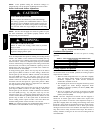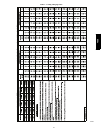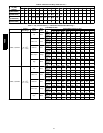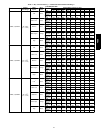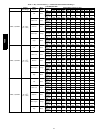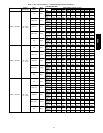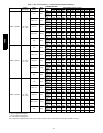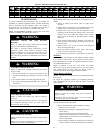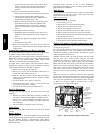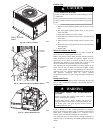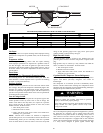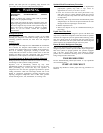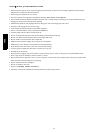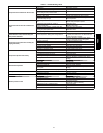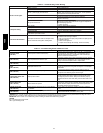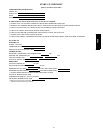
28
e. Loosen setscrew(s) that secures wheel to motor shaft,
remove screws that secure motor mount brackets to
housing, and slide motor and motor mount out of
housing.
2. Remove and clean blower wheel as follows:
a. Ensure proper reassembly by marking wheel orientation.
b. Lift wheel from housing. When handling and/or
cleaning blower wheel, be sure not to disturb balance
weights (clips) on blower wheel vanes.
c. Remove caked--on dirt from wheel and housing with a
brush. Remove lint a nd/or dirt accumulations from
wheel and housing with vacuum cleaner, using soft
brush attachment. Remove grease and oil with mild
solvent.
d. Reassemble wheel into housing.
e. Reassemble motor into housing. Be sure setscrews are
tightened on motor shaft flats and not on round part of
shaft.
f. Connect 5 pin plug and 4 pin plug to indoor blower
motor.
g. Reinstall unit access panel.
3. Restore electrical power to unit. Start unit and check for
proper blower rotation and motor speeds during heating and
cooling cycles.
Induced Draft (combustion air) Blower Assembly
The induced--draft blower assembly consists of the inducer motor,
the blower housing, and the induced-- draft blower wheel.
Clean periodically to assure proper airflow and h eating efficiency.
Inspect blower wheel every f all and periodically during the heating
season. For the first heating season, inspect blower wheel
bimonthly to determine proper cleaning frequency.
To inspect blower wheel, remove draft hood assembly. Shine a
flashlight into opening to inspect wheel. If cleaning is required,
remove induced--draft blower assembly as follows:
1. Remove unit access panel (See Fig. 20).
2. Remove the 5 screws that attach induced--draft blower as-
sembly to the flue collector box cover .
3. Slide the assembly out of the unit. (See Fig. 21). Clean the
blower wheel. If additional cleaning is required, continue
with Steps 4 and 5.
4. To remove blower wheel, remove 2 setscrews.
5. To remove inducer motor, remove screws that hold the
inducer motor to the blower housing.
6. T o reinstall, reverse the procedure outlined above.
Flue Gas Passageways
To inspect the flue collector box and upper areas of the heat
exchanger:
1. Remove the induced draft blower assembly according to
directions in the Induced Draft Blower Assembly section.
2. Remove the 11 screws holding the flue collector box cover
(See Fig. 19) to the heat exchanger assembly. Inspect the
heat exchangers.
3. Clean all surfaces, as required, using a wire brush.
Limit Switch
Remove unit access panel. Limit switch is located on the blower
partition.
Burner Ignition
Unit is equipped with a direct spark ignition 100 percent lockout
system. I gnition module (IGC) is located in th e contro l box (See
Fig. 19). Module contains a self--diagnostic LED. During
servicing, refer to label diagram or Table 5 in these instructions for
LED interpretation.
If lockout occurs, unit may be reset by either momentarily
interrupting power supply to unit or by turning selector switch to
OFF position at the thermostat.
Main Burners
At the beginning of each heating season, inspect for deterioration
or blockage due to corrosion or other causes. Observe the main
burner flames and adjust, if necessary.
Removal of Gas T
rain
To remove the gas train for servicing:
1. Shut off main gas valve.
2. Shut off power to unit and install lockout tag.
3. Remove unit access panel (See Fig. 20).
4. Disconnect gas piping at unit gas valve.
5. Remove wires c onnected to gas valve. Mark each wire.
6. Remove ignitor and sensor wires at the ignitor module.
7. Remove the mounting screw that attaches the burner rack to
the unit base (See Fig. 19).
8. Slide the burner rack out of the unit (See Fig. 19 and 22).
9. T o reinstall, reverse the procedure outlined above.
Outdoor Coil, Indoor Coil, and Condensate Drain Pan
Inspect the condenser coil, evaporator coil, and condensate drain
pan at least once each year.
The c oils are easily cleaned when dry; therefore, inspect and clean
the coils either before or after each cooling season. Remove all
obstructions, including weeds and shrubs, that interfere with the
airflow through the condenser coil.
Straighten bent fins with a fin comb. If coated with dirt or lint,
clean the coils with a vacuum cleaner, using the soft brush
attachment. Be careful not to bend the fins. If coated with oil or
grease, clean the coils with a mild detergent and water solution.
Rinse coils with clear water, using a garden hose. Be careful not to
splash water on motors, insulation, wiring, or air filter(s). For best
results, spray condenser coil fins from inside to outside the unit. On
units with an outer and inner condenser coil, be sure to clean
between the coils. Be sure to flush all dirt and debris from the unit
base.
Inspect the drain pan and condensate drain line when inspecting
the coils. Clean the drain pan and condensate drain by removing all
foreign matter from the pan. Flush the pan and drain trough with
clear water. Do not splash water on the insulation, motor, wiring, or
air f ilter(s). If the drain trough is restricted, clear it with a
“plumbers snake” or similar probe device.
Integrated
Gas Unit
Controller
(IGC)
Induced Draft
Motor
Rollout
Switch
Mounting
Screw
Burner
Rack
Inducer
Blower
Housing
Flue
Collector
Box
Interface Fan
Board (IFB)
Auto Transformer
fuses used on 460
volt units only.
(Hidden)
A08583
Fig. 19 -- Blower Housing and Flue Collector Box
48ES



